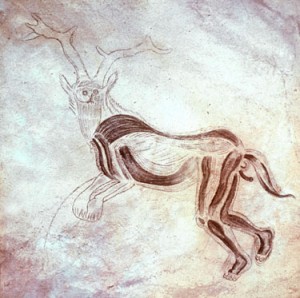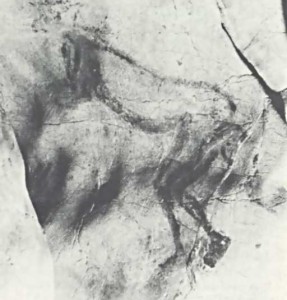Cave Art Cobblers? July 6, 2011
Author: Beach Combing | in : Prehistoric , trackback
Cave art has always been plagued by accusations of fakery or exaggeration: the fate of any discipline that lacks coordinates. So the original discovery of palaeolithic wall art at Altamira in 1879 by Don Marcelino de Sautuola (or rather his daughter Maria – another post another day) was universally decried as a hoax or an embarrassing misunderstanding at the time. It was not until further discoveries at Dordogne in 1901 – naturally, life being a sod, discoveries that took place after Don Marcelino’s death – that prehistorians began to take Altamira seriously. Then for an unhealthy dose of exaggeration just open any modern book on palaeolithic art with their interesting but unsubstantiated fantasies about Flintstone shamans…
In all this bickering and bitching one image though is sacrosanct: the sorcerer of Trois-Frères in southern France. Discovered in 1914 the cave art at Trois-Frères is admittedly Johnny-come lately stuff, dating back perhaps to a mere 13000 BC, nothing when compared to the extraordinary art work at Chauvet that dates back more than 30000 years and that might be the oldest surviving painting in the world.
But even with these minor qualifications there is something bewitching about the strange antlered figure. Beach was, many years ago, gifted a copy by an undergraduate and considers the picture so sacred that he won’t even hang it up in his study. Instead, every so often he unrolls the beast and just stares at the hybrid secret with its ill-proportioned antlers, the slanting face, the clearly human feet and the strange, floppy penis. So much of our past crumbles upon examination. What a relief that here at the beginning of European ‘history’ we have one simple fact, one representative glimpse of man’s long escape from the seasons.
Or do we?
Today Beach stumbled on this photo of the Sorcerer and almost choked on his elevensies. The ‘original’, that is the one known to the world and pictured at the head of the post, was sketched by Henri Breuil (obit 1861) in the 1920s. The charcoal lines may have faded since then, they might not come out well in photography but even so… Where are the antlers? And is that a phallus?
HB’s honesty is unquestionable but it looks very much as if his passion might have got the better of him.
So is this really caveman cobblers? drbeachcombing AT yahoo DOT com Beachcombing has already relegated his copy of the Sorcerer to the top and difficult to reach shelf: no more ecstatic unrolling for him, sigh…
***
Jack reminds Beachcombing of perhaps an even earlier sorcerer, though in reality no one knows what is being portrayed, ‘the Venus of Chauvet’ (another post, another day). The consensus is that we are looking at a patch of pubic hair and another sorcerer. Beach should add that the picture appears on a rock outcrop. Thanks Jack!
8 July 2011: SY writes in, ‘Ronald Hutton claims that ‘the figure drawn by Breuil is not the same as the one actually painted on the cave wall’ and that Breuil was fitting his drawing around some of his own prejudices about hunting magic: source, naturally, Wikipedia!’ However, Beach also got an email from renowned wanw expert Jean Clottes author of the brilliant Cave Art and the important Shamans of Prehistory who writes in to assuage RH’s and Beachcombing’s apprehensions. After some basic corrections of fact all now integrated (paleolithic for neolithic, Dordogne not the Pyrenees, and 1914 not 1911 for the Trois-Frères) JC gets down to business: ‘the photo of the Sorcerer you refer to is truncated at the top (which is why you cannot see the antlers: in any case, the antlers were engraved and are as a consequence far more difficult to photograph than the painted lines)’. JC’s opinion on the quality of Breuil’s tracing is emphatic: ‘Breuil’s tracing is quite honest and admitted by all specialists who have seen the so-called Sorcerer in the cave (I have seen it myself perhaps 20 times over the years (last time about one month ago) and I can assure you that it is quite well preserved and genuine!’ JC also notes in passing that in Les Trois-Frères ‘there is another image of a hybrid creature (a man standing with human legs, but with a big tail and the head of a bison, playing some musical instrument, probably a nose-flute) and that in a cave called Gabillou (in the Dordogne), there is another mythical creature quite similar (bison head with horns, tail, human arm and leg) right at the end of the cave (see its photo in J. Clottes, Cave Art, Phaidon, p. 129)’. Thanks to SY for the Ronald Hutton quotation and thanks to Professor Clottes for giving Beach his sorcerer back!!!!
10 July 2011: Ronald Hutton kindly wrote in on this point, ‘My point about the figure was that none of the experts in period to whom I had spoken (until Professor Clottes intervened) could agree exactly on what details in Breuil’s iconic portrait were actually present in the original. Professor Clottes is actually the very first whom I have encountered to vouch for the lot. As the Breuil representation was so clear and so constantly reproduced, this raised interesting questions in my mind about the nature of scholarly orthodoxies. My intervention was only to invite specialists to check the original more closely and reach an agreement over it: which does not yet seem to have happened.’ Thanks Prof Hutton!




